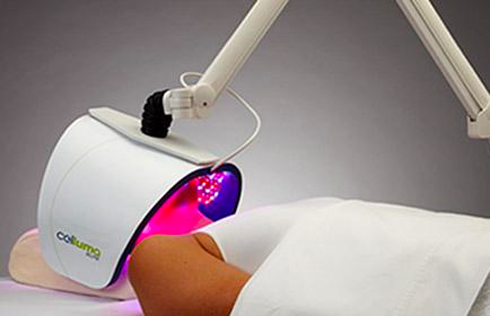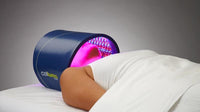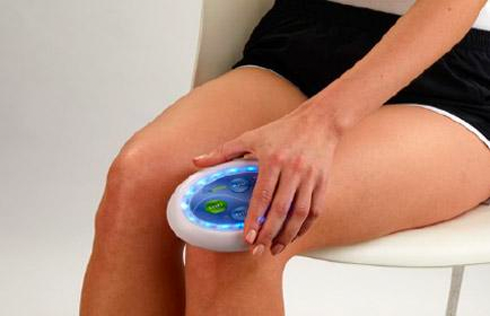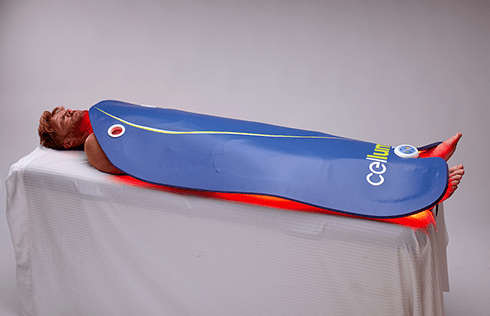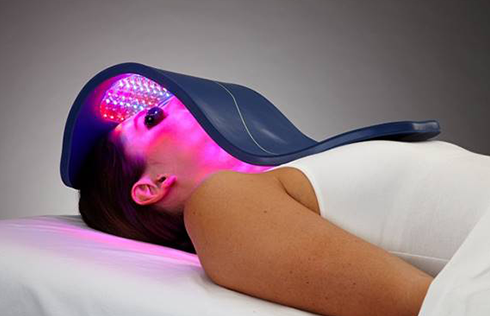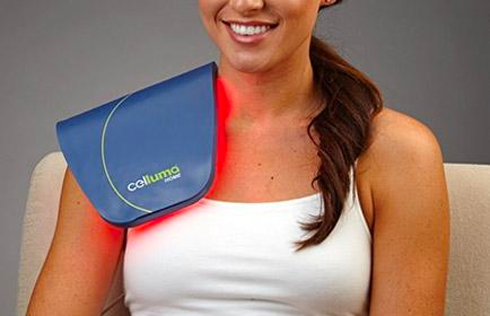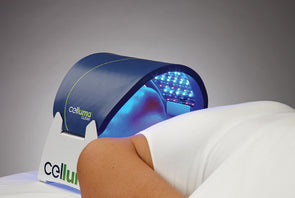Blue Light or Red Light? What is the Most Effective Color on the Light Spectrum for LED Light Therapy? And What are Wavelengths Anyway?

There are a lot of factors to consider when choosing an LED Light Therapy device. Questions can run the spectrum from what are the healing benefits to does it generate heat? And what about pulsing and wavelength options, including why to select red or blue light?
Getting these types of questions answered will help determine which device is right for you. Are you only looking for a device that benefits skin conditions such as acne or anti-aging, or are you interested in treating other types of disorders or seeking relief from general pain conditions?
Getting Your Questions Answered
We understand that selecting LED light therapy devices can be confusing and we appreciate the opportunity to provide some clarity to this process. Whether you’re looking for an effective acne treatment or simply something to rejuvenate your skin, you need to understand what is going to best address your concerns.
Your skin care is an important part of your health care routine and we want to make sure you get your most pressing LED light therapy questions answered. Especially questions related to what color wavelength is best and most effective for treating skin and pain conditions.
Global Leader in LED Light Therapy
As you can imagine, it took a herculean effort on the part of Celluma to design an innovative LED light therapy device capable of disrupting the global marketplace in a very few short years, especially given Celluma’s price points. But we did it, here’s how Celluma became a global leader in LED light therapy.
Follow the Science for Healthy Skin and More
In designing and developing the Celluma, we first examined credible scientific research from prestigious facilities around the world, including NASA (National Aeronautics and Space Administration) and DARPA (Defense Advanced Research Projects Agency). Based on those findings, the parameters for the Celluma SERIES emerged.
Understanding the Research and Treatment Options
We understand that the benefits of LED light therapy are dependent upon several factors, one being the correct wavelengths (perceived by humans as color).
First and foremost, it is important to use wavelengths (colors) that are absorbable by the mitochondria, meaning wavelengths that can penetrate the skin deep enough to reach the targeted cells in order to achieve the desired treatment result.
We also know that there is a range of wavelengths which have the ability to be absorbed by chromophores in the cell membrane and the mitochondria.
Proven Wavelengths
For effective treatment of skin, pain, acne and hair loss issues, the only proven wavelengths are blue, red and near-infrared. These wavelengths are in the visible range to just outside the visible range - from approximately 400-1000nm.
Other wavelengths, including green, yellow, orange, and amber are not scientifically supported for a variety of reasons.
One of the easiest ways to explain light therapy is to think of it as photosynthesis for mammals. Just like plants, scientific research has shown that human bodies can absorb light particles called photons and, as discussed above, transform that light energy into adenosine triphosphate or ATP.
As we age, the ability of our cells to produce energy diminishes. Cellular energy production is also effected by disease and poor lifestyle habits. Light therapy increases cellular energy!
It’s also important to understand what near red light and infrared light therapy is not. It is not the same light used in tanning booths and it does not expose your skin to harmful UV wavelengths.
Wavelengths Matter
Keeping in mind that the longer the wavelength the deeper the penetration, this would indicate that red light (color) wavelengths used to upregulate the mitochondrial process in cells are between 630 - 700nm and there will be very little difference in how cells respond to a 630 wavelength versus a 660 wavelength, meaning both will be effective, however a 660nm may reach cells at a slightly deeper depth.
Likewise for near-infrared, the ideal range is 700-900nm. Most of the better devices use wavelengths in the 800-900 range for their ability to penetrate so deeply below the surface of the skin and into the sub-cutaneous layer.
In Celluma light therapy devices, we use 880nm which is the near-infrared wavelength used by renowned researcher Dr. Harry Whelan in his research for NASA on the treatment of wound healing in many studies.
What Do the Colors Red, Blue, and Near Infrared Mean?
Humans see blue and red wavelengths as blue and red colors. However, near-infrared wavelengths are invisible to the human eye. Red wavelengths are used to benefit a variety of skin conditions and reduce inflammation, redness and puffiness. Additionally, red wavelengths increase blood flow to generate new healthier tissue and move toxins out of the body.
What to Know About Acne and Blue Light
In medical aesthetics, for the treatment of acne, blue wavelengths are required to kill acne causing bacteria.
If you are interested in the treatment of acne vulgaris, then a blue wavelength (color) between 400-470nm is required. Unlike red light and near-infrared, blue is not used for upregulating mitochondrial function but to create a photo-toxic event for the C. acnes bacteria.
To quote renowned researcher Dr. Michael Hamblin, (Low Level Laser (light) Therapy (LLLT) for Cosmetic Medicine and Dermatology), “One mechanism of action of phototherapy is via the excitation of porphyrins generated by C. acnes as part of its normal metabolism. These porphyrins act as endogenous (produced within the cell) photosentizers, absorbing light (specifically blue, and to a lesser extent, red) and stimulating photochemical reactions that generate free radicals and single oxygen species that are toxic for C. acnes.”
Additionally, using a LED light therapy device with red light will reduce the inflammation associated with the acne lesions, stimulate healing, and reduce the potential for scarring of the skin.
Near-Infrared for Pain and More.
Near-infrared wavelengths are often considered the “pain” wavelengths for their ability to reach deeper into the tissue where much of our pain, muscle, and joint issues reside. However, near-infrared also affects cells in a similar manner to red wavelengths.
Other Factors
Effective Power Requirements
When it comes to power parameters it gets very confusing. Because we are talking about low- level or LED light therapy, it’s all about how much energy is available for absorption, not the power of the device - as long as the power available for absorption by the cells is within the correct range.
Pulsing Versus Continuous Wave Delivery of Light Energy (wavelengths)
The science bears out that pulsed delivery of light energy appears to enable the cells to absorb more of the light energy over the treatment session. Bottom line? Most devices are not sophisticated enough to even offer pulsing as an option, so look for devices that provide this added benefit.
Celluma devices are designed to optimize results, so all devices come with the option to turn pulsing on or off depending on your professional or personal preference. Whether pulsed or continuous wave delivery, the result is the same. Meaning, more adenosine triphosphate (ATP) is generated.
The whole purpose of light therapy is to increase ATP which enables higher performance in cells which are compromised. Pulsing has nothing to do with excitability, it just means there is a possibility that more energy is absorbed by the cells. And more energy absorption is always favorable to increasing ATP. This is how red light and near-infrared light therapy works.
Dispelling Myths
Despite what you may read elsewhere, LED devices do not emit thermal energy. LEDs by their very nature are non-thermal, there is no bulb, and no filament to heat up.
The benefit of light therapy is derived from non-thermal light energy which is emitted in the form of photonic energy and which is absorbable by the mitochondria in our cells. The mitochorndria are the powerhouses within each cell that generates the necessary energy for cells to do their job effectively.
Top Light Therapy Researchers
There are several leading researchers in the field of low-level light therapy (LLLT). Dr. Tina Karu conducted ground-breaking early work in this area.
In her 2008 paper “Mitochondrial Signaling in Mammalian Cells Activated by Red and Near-Infrared Radiation”, she explains that “Photobiomodulation uses monochromatic and quasimonochromatic light in the optical region of 600–1000 nm from lasers and light-emitting diodes to treat in a nondestructive and nonthermal fashion various soft tissue and neurologic conditions (reviews: 9,10). Nowadays it is thought that this kind of treatment is based on the ability of light to alter cell metabolism as a result of its being absorbed by mitochondria (7, review: 8) and cytochrome c oxidase in particular (11–14).
More Important Studies
Still on the subject of wavelengths (colors), Dr. Daniel Barolet explains the desired wavelength range in his 2008 paper LEDs in Dermatology.
The following is an excerpt from that paper from the paragraph called:
Well-Absorbed Deeply Penetrating Wavelength
Light is measured in wavelengths and is expressed in units of nanometers (nm). Different wavelengths have different chromophores and can have various effects on tissue (Fig. 6). Wavelengths are often referred to using their associated color and include blue (400-470 nm), green (470-550 nm), red (630-700 nm) and NIR (700-1200) lights. In general, the longer the wavelength, the deeper the penetration into tissues 8-10. Depending on the type of tissue, the penetration depth is less than 1 mm at 400 nm, 0.5 to 2 mm at 514 nm, 1 to 6 mm at 630 nm, and maximal at 700 to 900 nm.
Take Note of Key Facts
What’s notable in this paper is that Dr. Barolet explains the ideal range of wavelengths for blue light, red light, and near-infrared colors.
In Celluma LED light therapy devices, we didn’t use the color green as there is very little credible research to support its value in upregulating the mitochondrial process.
In short, although green light is further away than blue light from harmful UV ionizing radiation, it does not penetrate deep enough in tissues to reach dermal chromophores; the molecules that absorb light energy.
What the Studies Say
Several in vitro studies show that green can stimulate fibroblasts, hepatocytes (Castro 2003), neurons, adipocytes (Roche 2017, Jackson 2013), mitochondria (Kassak 2005) etc.
However, academia is still waiting for a clear demonstration of its clinical efficacy.
Furthermore, green is significantly absorbed by melanin in the epidermis increasing the risk of persistent hyperpigmentation!
(For more information on the color green light, click here to read a previous blog about the use of green light in LED light therapy.)

More Research
With regard to Dr. Whelan’s research, one study “Clinical and experimental applications of NIR-LED photobiomodulation” from the Department of Clinical Laboratory Sciences, University of Wisconsin-Milwaukee, 53226, USA, states: “Low-intensity light therapy, commonly referred to as ‘photobiomodulation,’ uses light in the far-red to near-infrared region of the spectrum (630-1000 nm) and modulates numerous cellular functions. Positive effects of NIR-light-emitting diode (LED) light treatment include acceleration of wound healing, improved recovery from ischemic injury of the heart, and attenuated degeneration of injured optic nerves by improving mitochondrial energy metabolism and production. NIR-LED light represents a novel, noninvasive, therapeutic intervention for the treatment of numerous diseases linked to mitochondrial dysfunction.”
And Even More Research
In another paper, Low-Level Light Therapy with Light-Emitting Diodes for the Aging Face by R. Glen Calderhead, MSc, PhD, David B. Vasily, MDb, Dr. Karu’s findings are again quoted “The preeminent Russian photobiologist Tiina Karu⁹ has identified the photo-biomodulation band at around 620 nm visible red to around 1000 nm in the near infrared; based on the data seen in Fig. 4, the reader will understand why: minimal absorption in competing chromophores will allow deeper penetration with absorption in nonpigmented chromophores, such as cytochrome c oxidase (CCO) for visible light and elements on the cell membrane for infrared light.10.”
The Celluma Difference
As mentioned previously, when designing the Celluma SERIES of light therapy devices, it was our intention to be the first light therapy device to follow ALL the parameters for an effective LED device.
In addition to choosing proven wavelengths (and colors), we also paid attention to energy density, treatment time, pulsing and most importantly we designed the world’s only FLEXIBLE & SHAPE-TAKING panel-style device.
Most LED light therapy devices do not even have pulsing as an option, however, based on the consensus in the scientific research (discussed in Dr. Barolet’s paper LEDs in Dermatology), pulsing enables the cells to absorb more of the delivered energy over the treatment session as opposed to continuous wave delivery.
In Summary
Let’s talk about the color blue light and its impact on the skin. Blue light is the wavelength of choice for treating acne as it is a short wavelength of light energy and is at the peak of the light energy absorption curve.
The penetration depth of light energy is a function of the wavelength and the shorter the wavelength, the shallower penetrating the light energy.
As C. acnes bacteria resides close to the surface of the skin and blue light is very shallow penetrating, blue light is ideal for killing C. acnes bacteria.
And in the absence of C. acnes bacteria, you eliminate the fundamental source of acne vulgaris. This being the case, having an LED light therapy device that emits light energy in the blue color range is essential for every skin care professional looking for an effective acne treatment, as well as those home users looking to eliminate their acne issues.
The blue and red LED light therapy provides great aesthetic benefits including the treatment of acne and “maskne” and increasing collagen production to help reduce those under-eye wrinkles and laugh lines.
Near infrared provides medical benefits that are clinically proven to penetrate deep below the surface layer of the skin to better target muscle and joint pain, including arthritic pain, right where it starts. This gives people much needed pain relief from inflammation and injury.
For a more in-depth explanation of what blue LED light therapy does to the skin, click here. And for a more thorough explanation of near-infrared light therapy, click here.
With the wide spectrum of important options to consider (wavelengths, possible heat generation, pulsing, different colors, convenience and efficacy, etc.) having as much information as possible at your fingertips is key.
For more information about what the science says, click here.



